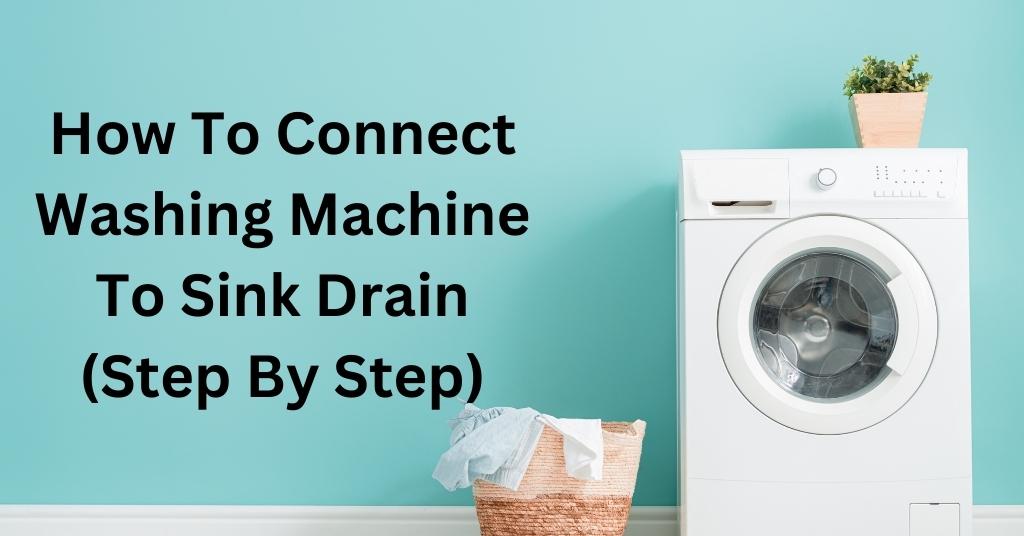A necessary designated plumbing system makes installing a washing machine easier. It only requires you to make the right drain and supply connections before plugging it into a working socket.
If you have an existing plumbing system, you must install the washer and connect the drain hose pipes accordingly.
Your washing machine and sink can drain into the same pipe with suitable measures.
In this article, I will teach you how to hook up a washing machine to a sink drain and also discuss if a washing machine needs a dedicated drain or not.
Connecting Washing Machine To Sink Drain

You can tie your washing machine to a sink drain as long as a vented pipe is tied into the drain to keep the water flow fluid. If both of them are together, you might be able to vent them with a single vent if they are close enough.
Here’s the step-by-step process to connect washing machine to a sink drain.
1. Connect The Water Supply Hoses
The supply hoses of your washer connect the top and front load machines with the valve to supply water after each cycle. A proper and kink-free connection provides them with a stable environment without any unnatural obstruction.
Make sure to unplug your washing machine before you begin anything.
Pull the back of the machine away from the wall to give you enough space to access the valves generally located towards the back of the washer.
The inlets are divided into cold water and hot water valves. Make sure to close them both.
If your washer is new, it should come with water supply hoses and all other necessary washing machine parts packaged. If they are not packed separately, check the drum of the machine, where they are usually stored.
Follow the steps below to connect the water supply hoses properly.
- Pull the washer away from the wall to screw the water supply hose connections towards the back of the machine.
- The water inlet valves are divided into cold and hot water valves. They generally have these marking on the rubber part of the hoses so pay extra attention to them when connecting.
- Once you have coordinated hot and cold-water supply valves, match the same connections to the other end of the valves.
- Try not to stretch any hoses in case they are shorter than anticipated, as this might break or kink the connection, leading to clogging in the future. Instead, purchase longer replacement hoses.
- Use a tight seal to prevent any leakage from the threading. Most washers have rubber connections to tape around the threading of the valve spigots or other connections.
2. Set Up The Drain Hose
With no proper drainage system installed for your washing machine, you can feed it into a sink drain hose. Usually, it is not that difficult to set up the drain hose with the sink drain.
If there is no designated or pre-planned plumbing for your new washer, you can also try to attach it to the sink drain pipe.
If you have a correct plumbing system installed for a washing machine, the sandpipe hose is also installed with it. You just have to insert one end of the drain pipe into the sandpipe.
However, if you do not have designated plumbing, follow the steps below to attach the drain hose to the sink.
- Attach the plastic hose guide that helps the hose end without any kinks or bends to avoid clogging.
- Use an extension hose if your drain pipe is short and can not reach the sandpipe. A new washer comes with a hose guide, but you can also purchase a new one if the existing is shorter than anticipated.
- Test the water supply to look for any leaks
- If there is a leak from any of the connections, tighten or adjust as needed.
PS: Avoid overtightening the connection as it can also damage a part of the hose which can further cause leaks by warping the connector’s rubber washer.
3. Hook Up The Washing Machine To The Sink
Hooking your washing machine drain pipe to the sink is very easy.
Follow the steps below if you do not have designated plumbing for the drain pipe.
1. Connect to the sink faucet
Use a sink aerator thread to the hose connection adapter to attach the water supply hose to the sink faucet. The adapter connects to the faucet, and the hose connects to the adapter.
2. Connect another end to the cold water connection
Connect the other end of the water supply hose to the cold-water connection on the back of the washing machine. This will allow you to control the water temperature from the sink faucet instead of the washing machine.
3. Attach the drain hose
Attach the drain hose to the sink to dispense the laundry’s water to the drain pipe.
4. Precautions while connecting the drain hose to the sink
Purchase a longer hose or an extension for your existing hose if the water supply hose is not long enough or the distance between the washer and sink is longer. Cover the unused hot-water connection with a hose cap to prevent leaks.
5. Make sure to test it
Do a test load of laundry to ensure nothing leaks and the washing machine runs well.
Does A Washing Machine Need A Dedicated Drain?
A dedicated drain is recommended for a washer. The same drain pipe for the sink and washer means the washer will only drain, and the sink will take the water out. This might cause a build-up of lint and debris from the clothes and lead to clogging.
Therefore, before setting up your brand new washer, weigh your options well enough to understand if it is better to invest in a designated drain system or if you should connect your washer’s drain to your sink drain.
The washer and sink can share the drain system, but it is not recommended as it complicates things further when it comes to repair and maintenance.
Most sinks and washers use standard 2-inch pipes, but some dryers and washers require larger pipes. Water will not flow properly inside smaller pipes, and thus, the washer might not function too.
Remember to take into account the size of the pipe before connecting the washer to the sink drain. The machine might clog the sink drain and cost you some extra bills.
Also, the washer needs more water than the kitchen faucet, which means installing an additional line to its base. Attaching another vent pipe between them might solve the problem.
Where Does The Washing Machine Drain Hose Go?
For new top load washers, the drain hose should be no more than 5″ down into the drain pipe. For front load washers, the drain hose should be no more than 7″ down into the drain pipe.
The drain hose might also be on the rear of the washer, with two separate hoses for cold and plight supplies.
The drain hose takes wastewater out of the washer while the hot and cold water inlet valves carry clean water in.
Remember to elevate the drain hose higher than the height of the washer to allow easy flow of the water.
This may prevent possible siphoning drawn by atmospheric pressure.
Final Remarks
You can connect your washer’s drain hose to the sink’s drain pipe if you do not have designated plumbing.
Following is a list of steps you need to check off your list when connecting your washing machine to a sink drain.
- Connect the water supply hoses.
- Set up the drain hose.
- Hook up the washing machine to the sink.

My name is Rick Kinney and I am the founder of ExHandyman. I have worked as a handyman for many years, and fixing stuff is my greatest pleasure in life.
